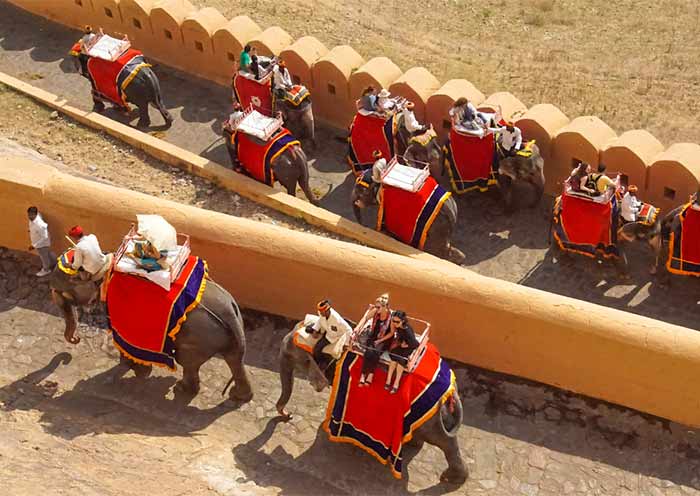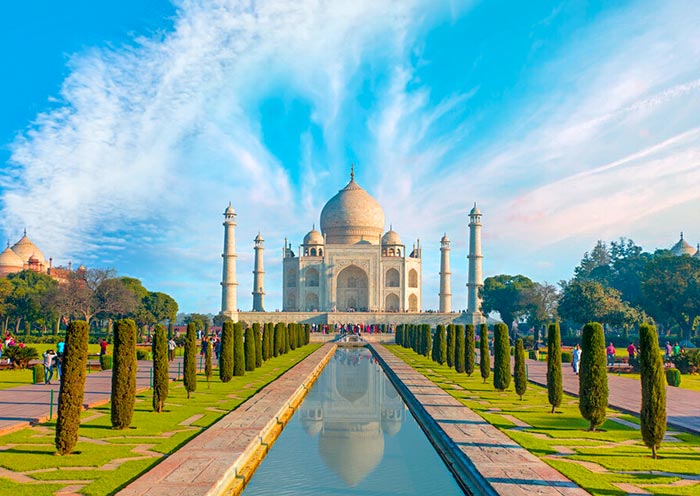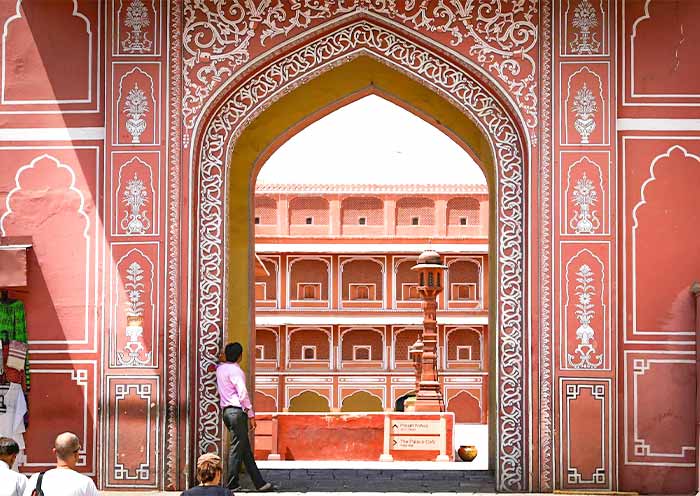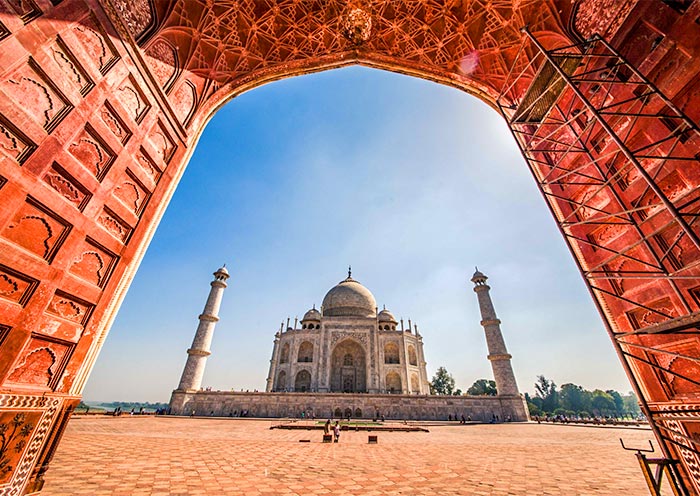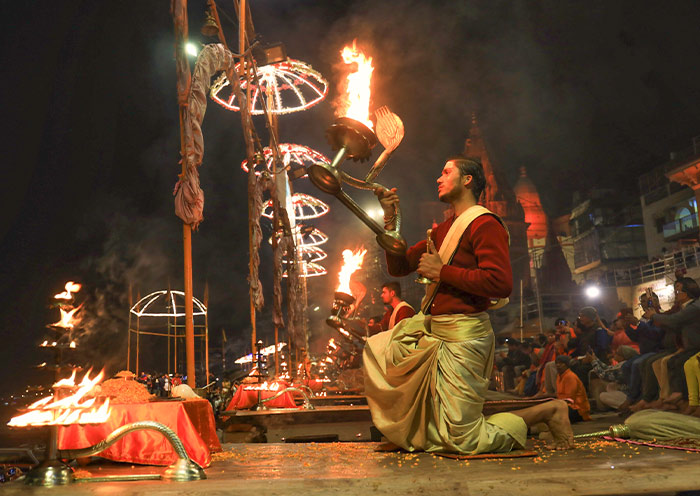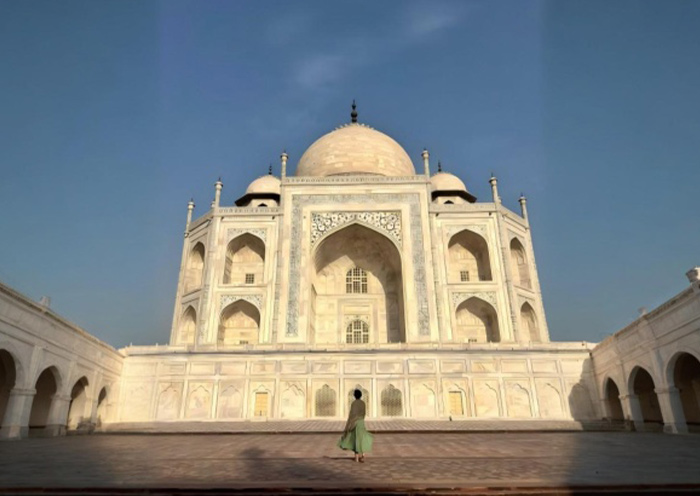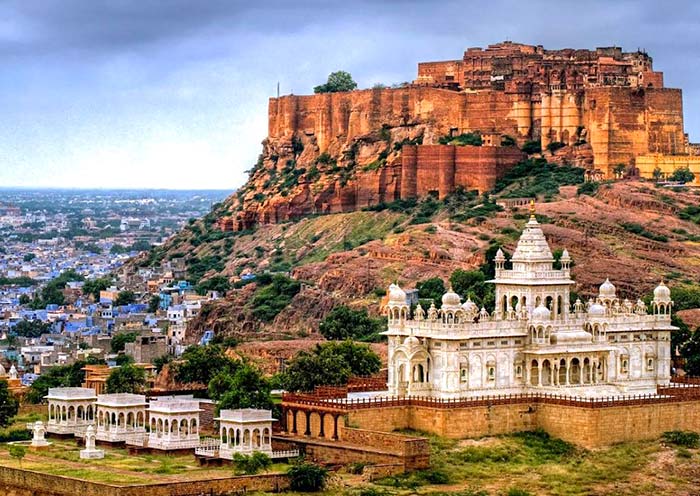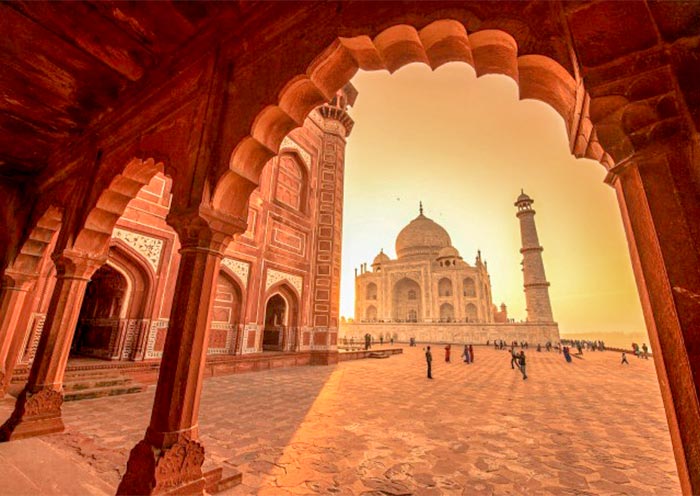India culture and history are beautifully intertwined, a vibrant mix of influences and eras that defy easy categorization. This Indian Cultural Attraction guide aspires to be comprehensive, but keep in mind that this Indian Cultural Attraction Guide is not an essay, but a road map that's practical and easy to read. The true magic lies in getting lost in the enchanting complexity of India's heritage itself! So, read on and discover the endless Indian attractions that await!
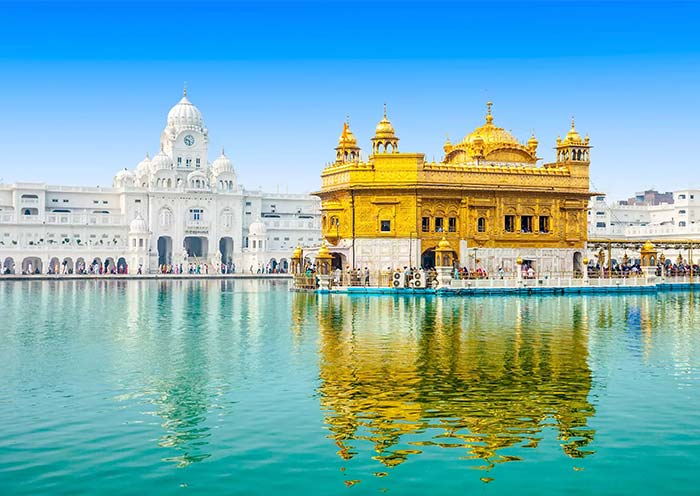

Cultural Heritage Attractions of Medieval India
In Medieval India, the Islamic Sultanates & Mughal Empire prospered, amalgamating Indian, Persian, and Islamic influences to create a rich cultural heritage. Among the top attractions of India are the famous Taj Mahal, Agra Fort, Fatehpur Sikri, Red Fort, Humayun's Tomb, and Qutub Minar. These famous attractions, designated as UNESCO World Heritage Sites, splendidly exhibit the architectural brilliance and enduring cultural heritage of the Mughal Empire in India.
1 Taj Mahal, Agra: Love Carved in Marble, Most Iconic Attraction in India
Taj Mahal (1632-1654 CE): Mughal dynasty, Islamic, Persian and Mughal styles with Timurid influences.
The Taj Mahal, the Most Famous Attraction in India, is an ivory-white marble mausoleum that stands as a timeless symbol of love. Taj Mahal was commissioned by the Indian Mughal emperor Shah Jahan in memory of his third wife Mumtaz Mahal. More than 20,000 Indian artisans dedicated 22 years of their lives to construct this remarkable and renowned monument.
The Taj Mahal's fame goes beyond its historical significance. This Indian attraction's white marble radiates a captivating glow, beautifully reflecting in the calm waters of its surrounding pools. Elaborate floral designs grace its walls, while the four meticulously arranged gardens create a tranquil and harmonious ambiance. Tourists are left in awe of the Taj Mahal's magnificence, its intricate craftsmanship, and the serene atmosphere the most famous Indian attraction exudes.
- Location: Agra, Uttar Pradesh, India
- Opening Hours: Daily except Fridays (sunrise to sunset)
- Ticket Prices: Foreign Tourists: ₹1100/$15 (entry only) + ₹200/$3 (optional mausoleum access)
- Tip 1: Visit Taj Mahal before sunrise, sunset or full moon night for best views!
- Tip 2: Tour Group enjoys a separate entry(skipping the long queue) and better chance to get limited tickets for full moon view
- Tip 3: Security check at the most famous Indian attractions can be more strict. Be prepared
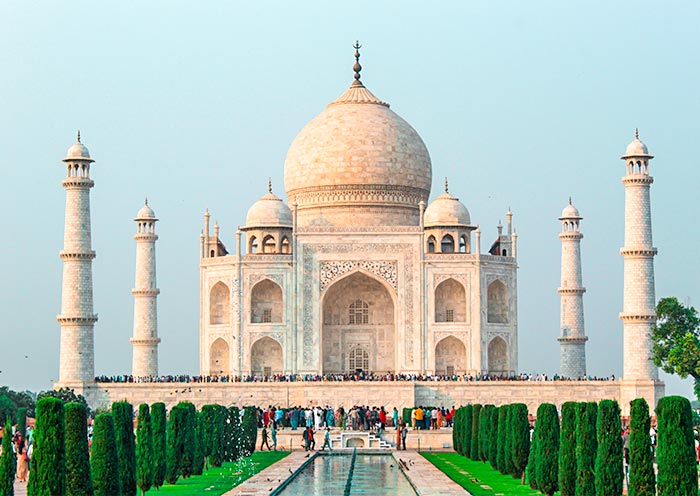
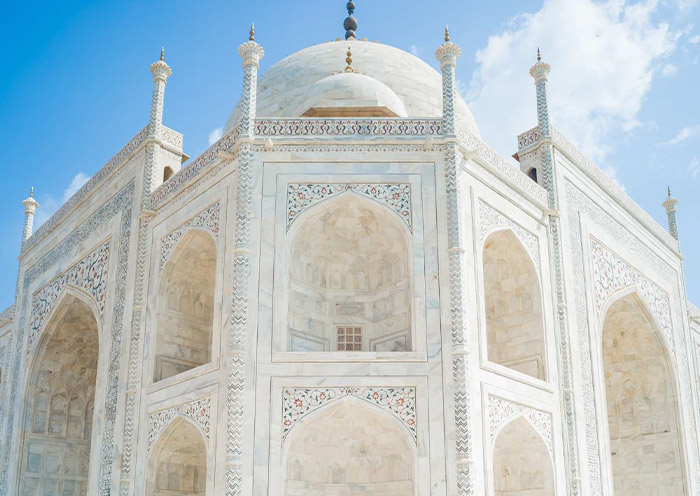
2 The Red Fort: Power & Glory, Famous Heritage of India's Mughal Dynasty
Red Fort Complex (1638-1648 CE): Mughal dynasty, Indo-Islamic architecture.
The Red Fort Complex, a top Indian attraction and a significant cultural heritage site in Delhi, India, stands as a majestic symbol of Mughal power and architectural splendor. Constructed by Emperor Shah Jahan in the mid-17th century, this opulent fortress served as the lavish residence of Mughal emperors for nearly two centuries. Recognized as a UNESCO World Heritage Site, the Red Fort not only represents a monumental structure but also embodies the harmonious fusion of Persian and Indian architectural styles that flourished under Mughal rule.
Enclosed within the fort's expansive red sandstone walls is a captivating city waiting to be explored. tourists can marvel at the breathtaking Pearl Mosque, an exquisite testament to Mughal artistry. They can envision the grandeur of royal life in the vast Diwan-i-Am (Hall of Public Audience). The Hall of Private Audience, adorned with intricate carvings, offers a glimpse into the emperor's private quarters. The fort's lush gardens, tranquil water channels, and ornately decorated pavilions transport tourists back in time to its glorious past, allowing them to experience the grandeur and heritage of the Mughal era.
Red Fort Complex Attraction Information:- Location: Netaji Subhash Marg, Chandni Chowk, Old Delhi
- Opening Hours: Daily except Mondays (9:30 AM to 4:30 PM)
- Ticket Prices: Foreign Tourists: ₹350 (approx. USD 4.30)
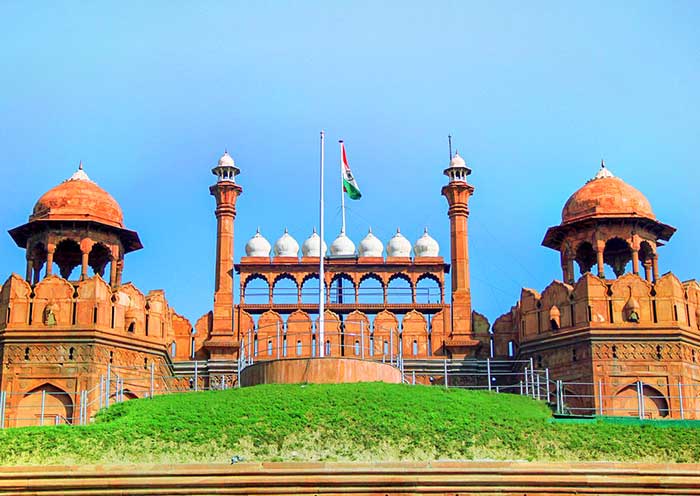
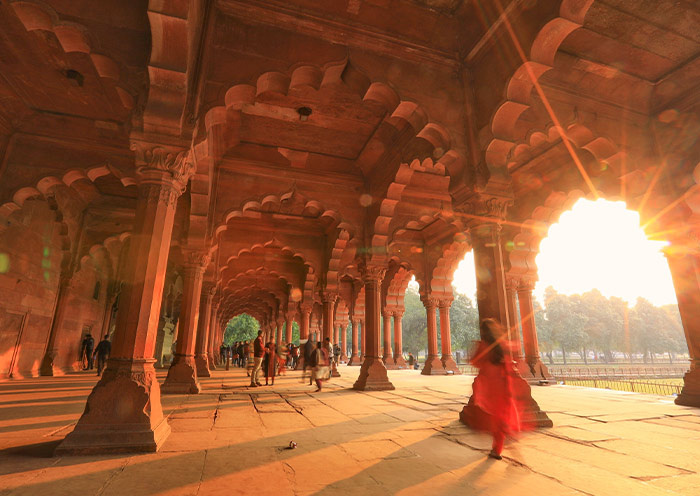
3 Agra Fort: Red Sandstone Wonder, Attraction Right Next to Taj Mahal
Agra Fort (1565-1573 CE): Mughal dynasty, Indo-Islamic architecture.
Situated on the banks of the Yamuna River in India, Agra Fort is a top cultural attraction and a UNESCO World Heritage Site celebrated for its rich historical significance. Built by the Indian Mughal emperor Akbar in the 16th century, Agra Fort served as a formidable military stronghold and the seat of Mughal power for nearly a century. Enclosed within its sturdy red sandstone walls is a splendid fusion of architectural styles that beautifully showcases the grandeur of the heritage of Indian Mughal era.
At this famous attraction in India tourists can wander through the majestic Jahangir Mahal palace, admire the intricate carvings embellishing the Diwan-i-Am (Hall of Public Audience), and be enchanted by the mesmerizing allure of the Sheesh Mahal (Palace of Mirrors). Each of these architectural marvels provides a captivating glimpse into the lives of the Indian Mughal emperors and the exceptional craftsmanship of that era's heritage.
Agra Fort Attraction Information:- Location: Agra, Uttar Pradesh, India
- Opening Hours: Daily except Fridays (sunrise to sunset)
- Ticket Prices:Foreign Tourists: ₹500 approx. $ 6 (entry only)
- Tip: Check out the daily Light & Sound Show at Agra Fort
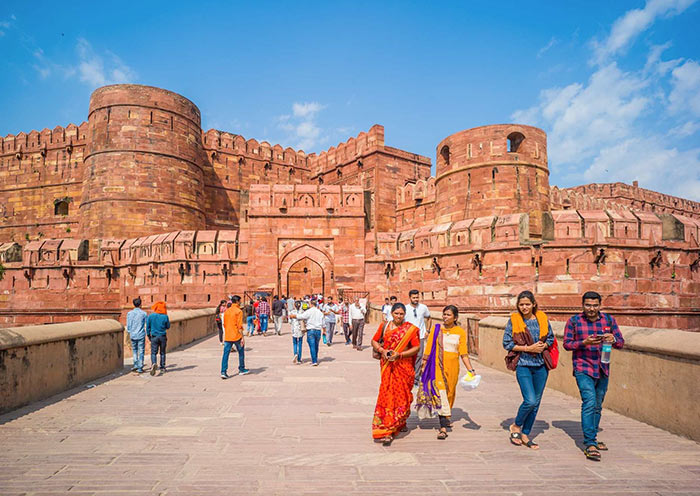
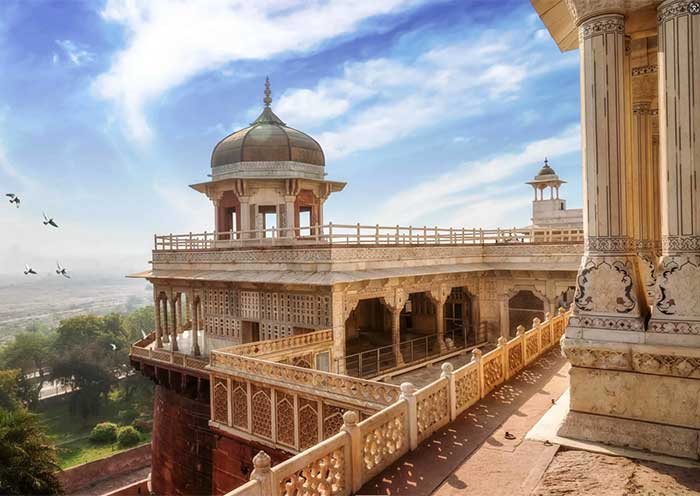
4 Qutub Minar: Echoes of Centuries, Sultan's Heritage in India
Qutub Minar (1193-1366 CE): Islamic monument, Delhi Sultanate (Mamluk and Khalji dynasties).
The Qutub Minar, a top Indian attraction and a symbol of India's cultural heritage, stands proudly in the heart of Delhi. Constructed in the 12th century by Qutub-ud-din Aibak, the first Sultan of Delhi, this architectural marvel served as both a victory tower and a minaret for a mosque. As a UNESCO World Heritage Site, the Qutub Minar embodies the harmonious blend of Islamic and Hindu architectural styles, reflecting the diverse influences that have shaped the history of Delhi.
The magnificence of the Qutub Minar lies in its intricate craftsmanship and imposing stature. tourists are captivated by the five distinct storeys, adorned with mesmerizing calligraphy and geometric patterns. Climbing the 379 steps rewards them with awe-inspiring panoramic vistas of the city. Exploring the surrounding Qutub Minar complex, which encompasses mosques and tombs, provides a deeperinsight into Delhi's past and offers a glimpse into the artistic legacy that spans across different eras.
Qutub Minar Attraction Information:- Location: Mehrauli, South Delhi, India
- Opening Hours: Daily (except Mondays) from 9:30 AM to 5:30 PM
- Ticket Prices:
- Indian Citizens & SAARC/BIMSTEC Countries: ₹30 (approx. USD 0.35)
- Foreign Tourists: ₹500 (approx. USD 6.10)
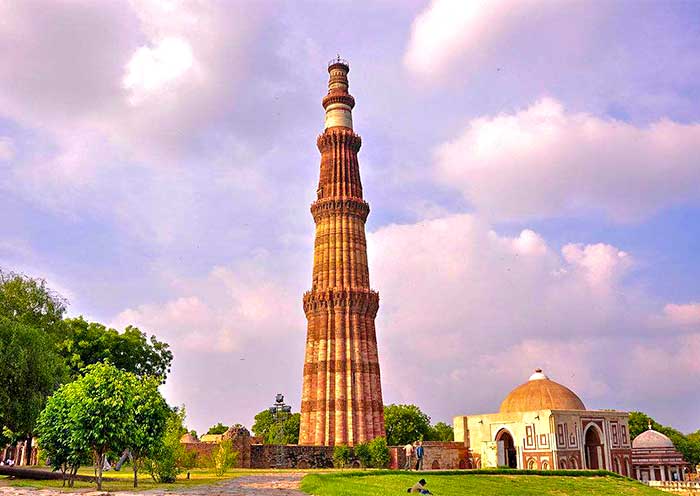
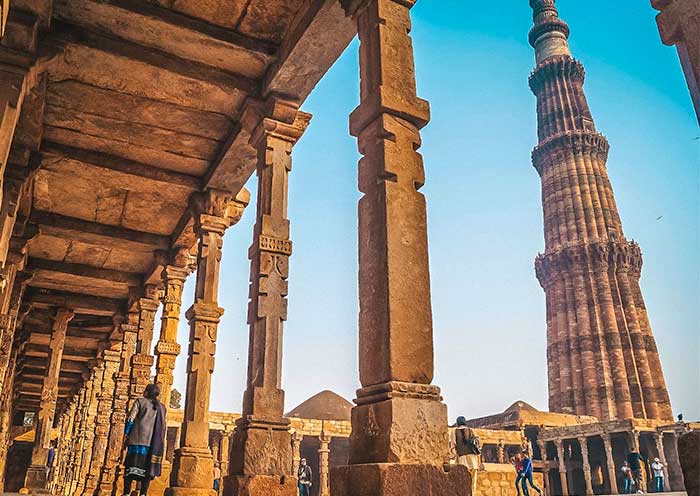
5 Jama Masjid, Old Delhi: Find Serenity at Top Indian Attraction Amidst the Bustle
Jama Masjid (1644-1656 CE): Mughal dynasty, Islamic architecture.
Located in the heart of Old Delhi, Jama Masjid (Friday Mosque) is a famous Indian attraction and one of the top cultural and heritage landmarks in India. This magnificent mosque, completed in 1656 by Mughal emperor Shah Jahan, showcases the grandeur and artistic mastery of the Mughal era. It stands as a significant place of worship, representing the rich Muslim heritage of the city.
Jama Masjid is renowned for its stunning red sandstone architecture adorned with intricate carvings, calligraphy, and towering minarets. tourists to this iconic attraction can marvel at the spacious prayer hall, the exquisite courtyard, and enjoy breathtaking panoramic views of the city from the rooftop. The serene atmosphere of the mosque, coupled with the melodious echoes of the call to prayer (azaan), offers a unique and spiritually enriching experience for tourists of all backgrounds, contributing to the allure of India's cultural and tourism landscape.
Jama Masjid Attraction Information:- Location: Delhi, India
- Opening Hours: Daily (sunrise to sunset)
- Entry Fee: Free
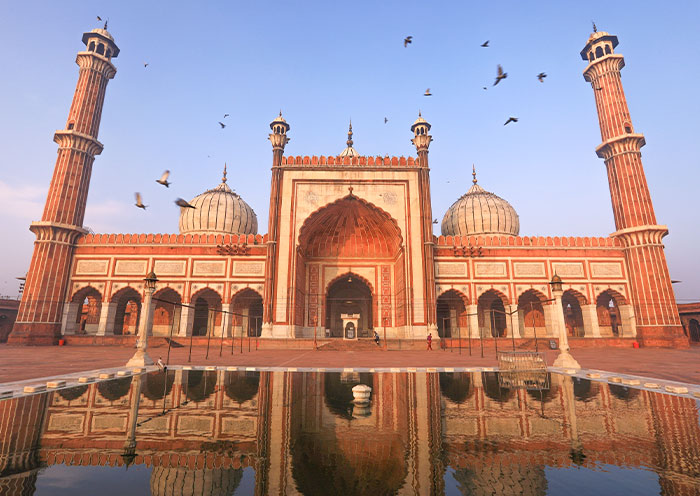
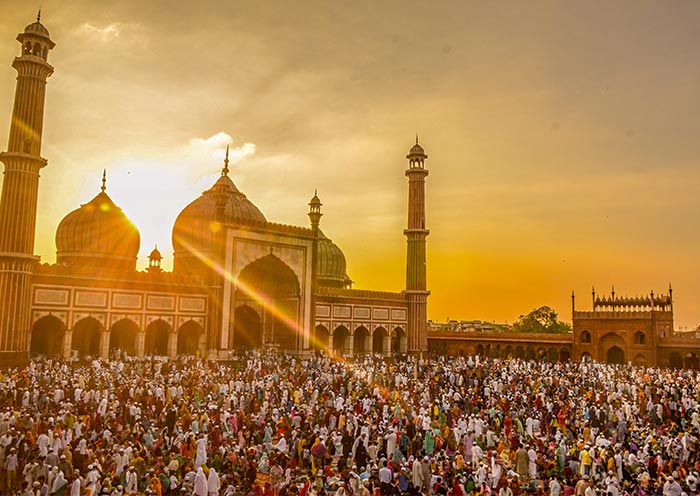
6 Humayun's Tomb: Mughal gardens with Persian grace, Fusion Heritage Site of India
Humayun's Tomb (1556-1572 CE): Mughal dynasty, Islamic and Timurid influences.
Humayun's Tomb, a top Indian attraction and an integral part of India's cultural heritage, stands proudly in the bustling city of Delhi. As a UNESCO World Heritage Site, it holds immense historical significance in Mughal history. Constructed in the mid-16th century by Emperor Humayun's wife, this architectural masterpiece serves as a precursor to the iconic Taj Mahal, showcasing the early stages of Mughal tomb architecture. The tomb's facade, crafted from red sandstone, seamlessly blends Persian and Indian architectural influences, representing a departure from the traditional octagonal style to a square base crowned by a central dome.
Be enchanted by the intricate geometric patterns and the subtle beauty of white marble embellishments adorning the red sandstone exterior. The expansive charbagh, a four-quartered garden, designed in the Mughal style, serves as a symbol of paradise and provides a serene escape within the vibrant city. Descending into the tomb chamber, tourists gain a glimpse into the historical significance of this architectural marvel. Humayun's Tomb stands as a testament to the exquisite artistry of the Mughals and invites exploration and contemplation within the dynamic cityscape of Delhi.
Humayun's Tomb Attraction Information:- Location: Nizamuddin East, Delhi, India
- Opening Hours: Daily (except Mondays) from 9:30 AM to 5:30 PM
- Ticket Prices: Foreign Tourists: ₹500 (approx. USD 6.10)
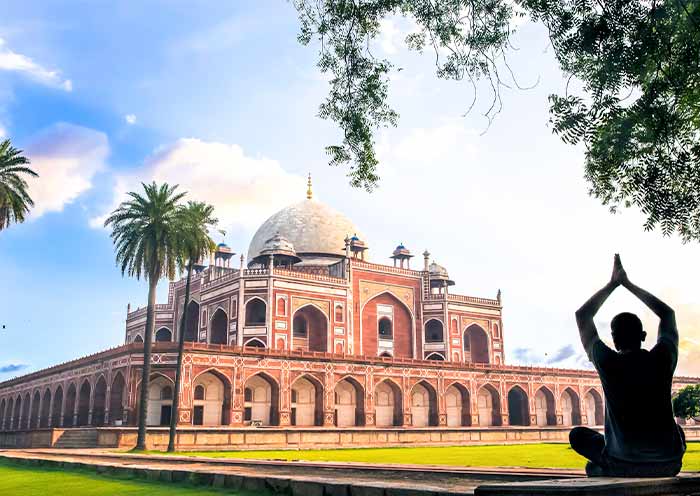
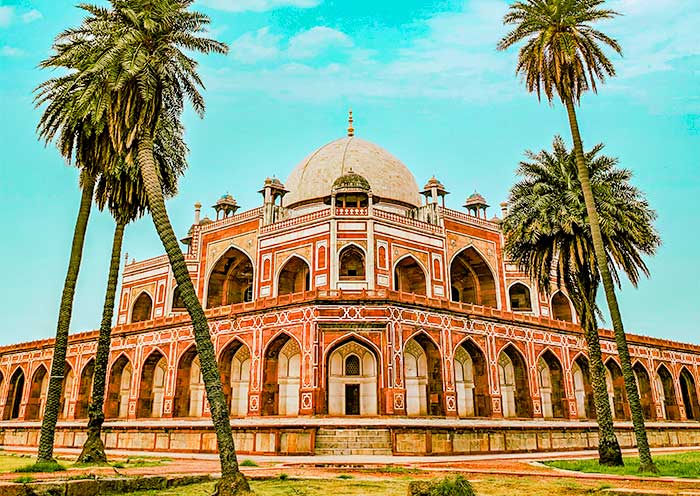
7 Tomb of Itimad-ud-Daulah: The "Baby Taj" Started the White Marble Trend in India
Tomb of Itimad-ud-Daulah (1622-1628 CE): Mughal dynasty, Islamic, Hindu and Timurid influences.
The Tomb of Itimad-ud-Daulah, an Indian attraction and a significant cultural heritage site in Agra, India, is often referred to as the "Baby Taj." Constructed by Mughal Empress Nur Jahan in the early 17th century, this captivating tomb stands as a beautiful testament to her affection for her father. As part of a UNESCO World Heritage Site, it holds immense historical and architectural importance, serving as a precursor to the iconic Taj Mahal and showcasing the early stages of Mughal tomb architecture's transition from red sandstone to white marble.
The allure of the Tomb of Itimad-ud-Daulah lies in its intricate craftsmanship and the juxtaposition of different materials. tourists are mesmerized by the exquisite white marble facade adorned with intricate floral designs, embellished with precious and semi-precious stone inlay work, creating a stunning visual spectacle. The contrasting red sandstone base and the tranquil ambiance of the surrounding gardens further enhance the experience, making it a top attraction for those exploring the rich heritage of Agra , India.
Tomb of Itimad-ud-Daulah Attraction Information:- Location: Agra, Uttar Pradesh, India (near the Taj Mahal)
- Opening Hours: Daily (sunrise to sunset)
- Ticket Prices: Foreign Tourists: ₹200 (approx. USD 2.45)
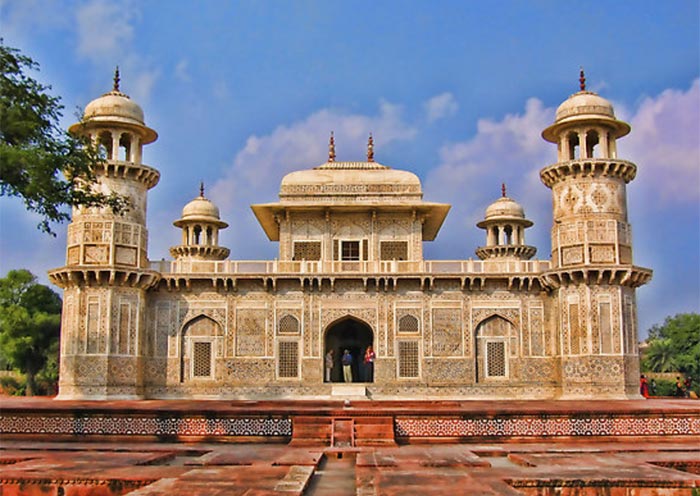
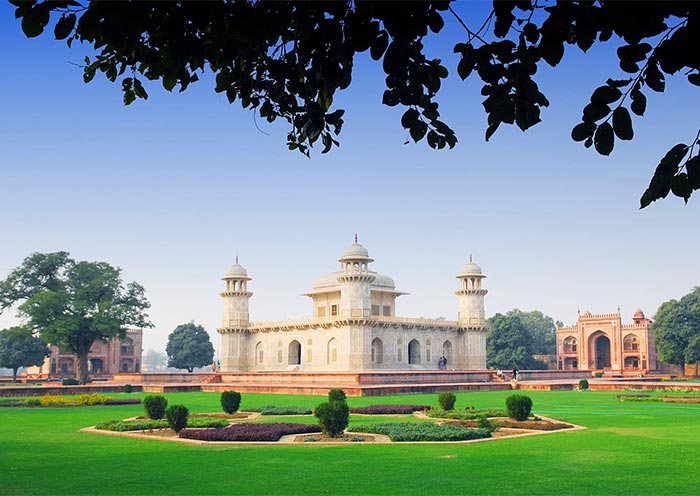
8 Golden Temple: Open Doors, Open Hearts of Sikh's Everlasting Heritage
Golden Temple (1577 CE onwards): Sikhism, a representation of religious tolerance and harmony, ongoing construction and modifications.
The Golden Temple, renowned as Harmandir Sahib, stands as a most exuberant Indian attraction and a significant cultural heritage site. Located in the city of Amritsar, Punjab, India, this UNESCO World Heritage Site holds immense importance for Sikhs, serving as their holiest gurdwara, or place of worship.
Constructed in the 16th century by Guru Ram Das, the fourth Sikh Guru, the Golden Temple holds a special place as a spiritual and cultural hub for the Sikh faith. Its architectural brilliance showcases the unique style of Sikh architecture, featuring a white marble structure adorned with a dome covered in gold leaf. Embraced by the temple is the Amrit Sarovar, a sacred pool of water, which is held in high reverence by Sikhs. Accessible via a causeway, symbolizing the equality of all individuals in the eyes of God, tourists can immerse themselves in the tranquil atmosphere of the temple and gain insights into Sikhism and its rich history.
Golden Temple Attraction Information:- Location: Amritsar, Punjab, India
- Opening Hours: 24 hours a day
- Free Entry: This attraction is free of charge, only a shoe deposit fee
- Langar: The Golden Temple complex also houses a langar, a community kitchen that serves free vegetarian meals to everyone, regardless of their faith or background.
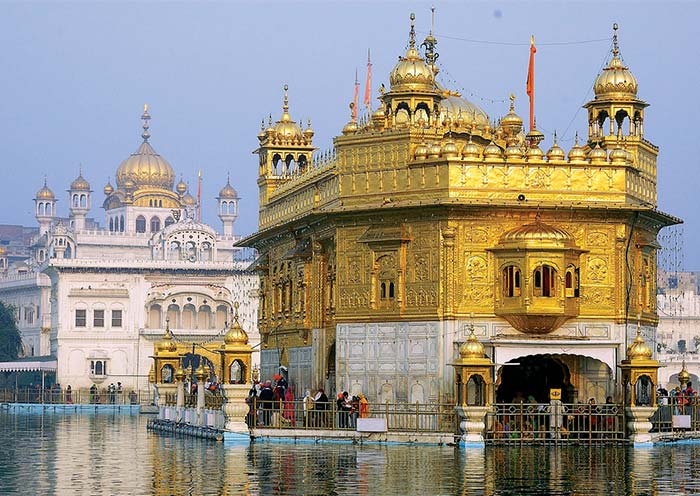
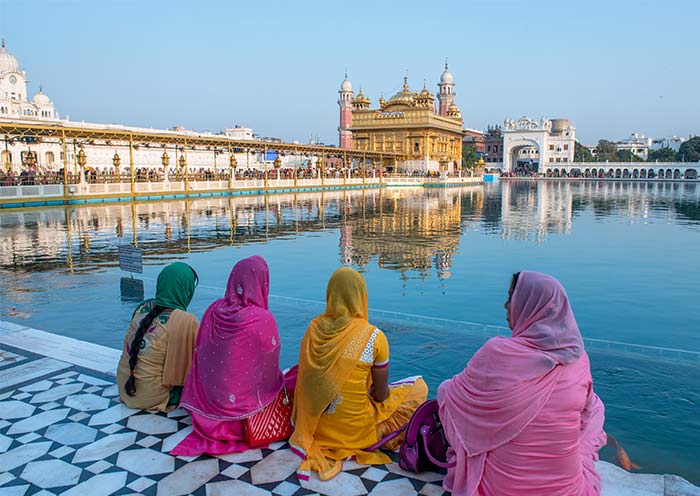
Attractions of Enigmatic Ancient India: Timeless Vedic Heritage
Ancient India was a cradle of civilization, culture, religion, and a treasure trove of cultural attractions. From the captivating cave temples of Ajanta and Ellora to the majestic Dravidian structures exemplified by the Meenakshi Temple, India's top cultural attractions boast architectural brilliance. These remarkable sites showcase the country's rich heritage and serve as a testament to its artistic legacy. India's ancient attractions offer a glimpse into its captivating heritage, making it a famous destination for cultural tourism.
9 Ajanta Caves: Masterpieces Whisper Stories in Stone, Must-see Ancient Attractions
Ajanta Caves (2nd century BCE - 1st century CE): Buddhist cultural heritage, Satavahana dynasty and Gupta Empire period.
The Ajanta Caves, a UNESCO World Heritage Site, date back to the 2nd century BCE. These rock-cut Buddhist cave temples hold immense cultural value. Initially, Hinayana/Theravadin followers of Buddhism carved six simple and austere caves, where Buddha was worshipped in an aniconic/symbolic form. Later, during the Mahayana phase, exquisite mural paintings adorned the walls, and new caves were excavated.
Tourists can marvel at the towering sculptures, the breathtaking frescoes depicting Buddhist legends, and the serene atmosphere. These caves exemplify one of the greatest achievements in ancient Buddhist rock-cut architecture and offer insights into India's socio-cultural, religious, and political history. The intricate details and vibrant colors offer a glimpse into the artistic mastery and spiritual beliefs of the era, making the Ajanta Caves a unique window into India's rich heritage.
10 Elephanta Caves: Hindu Deities Come Alive, Caves Housing Enchanting Heritage
Elephanta Caves (5th - 8th centuries CE): Hinduism (Trimurti - Shiva, Vishnu, Brahma).
The Elephanta Caves, a top Indian attraction and a UNESCO World Heritage Site, comprise a collection of cave temples primarily dedicated to the Hindu deity Shiva. These extraordinary caves are located on Elephanta Island, also known as Gharapuri, situated in Mumbai Harbour, around 10 kilometers (6.2 miles) east of Mumbai, in the Indian state of Maharashtra.
Carved meticulously from solid basalt rock, the Elephanta Caves showcase rock-cut stone sculptures, many of which are intricately crafted in high relief. These sculptures embody a harmonious blend of Hindu and Buddhist concepts and iconography, reflecting a syncretism of ideas. With immense historical and artistic significance, the caves serve as a visual narrative of Hindu mythologies, with elaborate carvings that depict captivating tales.
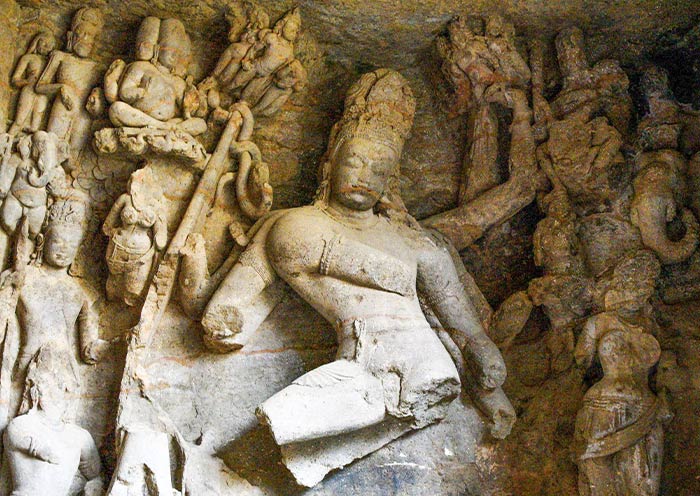
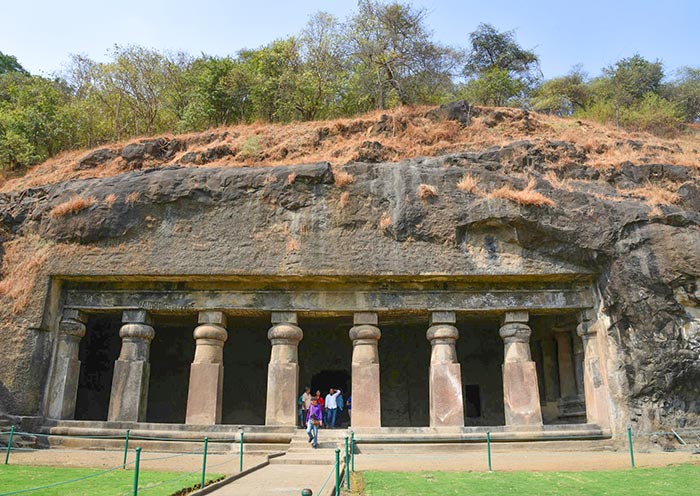
11 Sarnath: Follow the Buddha's footsteps in Iconic Attraction in India
Sarnath (3rd century BCE - 12th century CE): Buddhist pilgrimage site, Mauryan Empire and Gupta Empire period.
Sarnath (also known as Sāranganātha and 鹿野苑), situated near Varanasi, is a top Indian cultural attraction and one of the four most holy sites in Buddhism. The other three sacred sites include Lumbini, Nepal, Bodh Gaya, India, and Kushinagar, India. It holds immense significance for Buddhists worldwide, as it is the place where Buddha delivered his first sermon after attaining enlightenment. This pilgrimage site is a treasure trove of ancient history, art, and spiritual heritage.
Tourists to Sarnath have the opportunity to explore the Dhamek Stupa, a revered structure believed to mark the very spot where Buddha delivered his first sermon. (The stupa is not the original one built by Emperor Ashoka in the 3rd century BCE, but a later enlargement and reconstruction dating from the 5th to 6th centuries CE). They can marvel at the captivating ruins of ancient monasteries which offer a similar yet distinct vibe from temples in Kathmandu and Monasteries in Lhasa. You can admire the Ashoka Pillar, a towering column adorned with inscriptions that chronicle the early history of Buddhism. The original fragments of Ashoka Pillar's lion capital, along with other archaeological finds, are housed and preserved within the Sarnath Museum. Sarnath offers a deeply spiritual and enriching experience, providing a profound connection to the rich heritage of Buddhism and its teachings.
Sarnath Attraction Information:- Location: Sarnath, Uttar Pradesh, India (near Varanasi)
- Opening Hours: Daily (sunrise to sunset)
- Ticket Prices: Foreign Tourists: ₹150 (approx. USD 1.80)
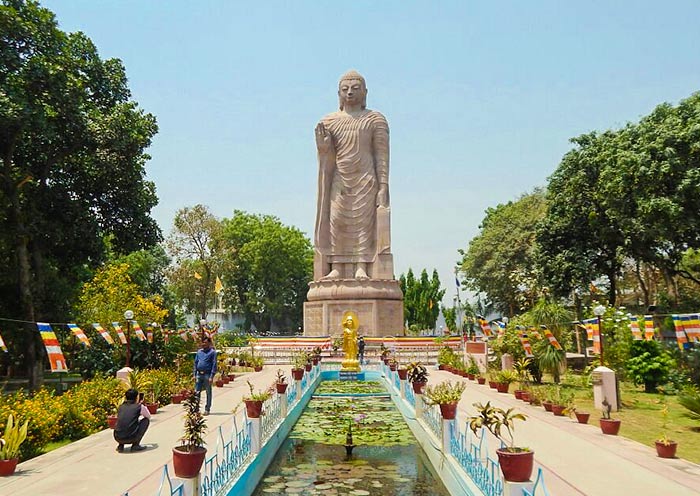
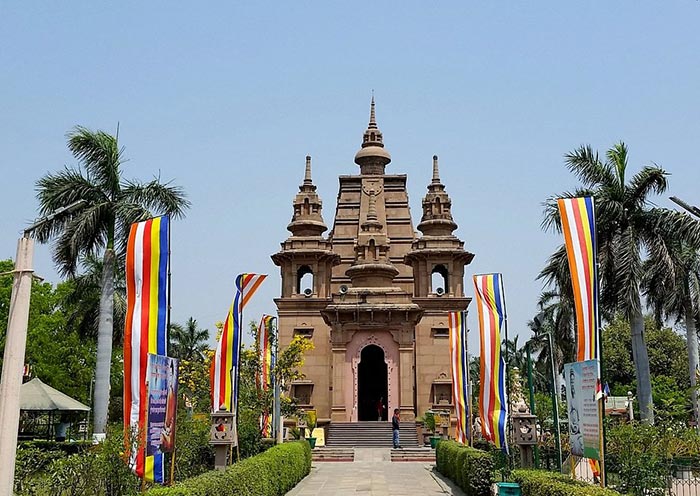
12 Dasaswamedh Ghat: Hindu Heritage Reflected in the sacred waters of the Ganges
Dasaswamedh Ghat (Unknown - Ongoing): Hindu religious site, associated with various Hindu dynasties and kingdoms.
Dasaswamedh Ghat (pronounced as "got" or "gaht", is a broad flight of steps leading down to a body of water), situated on the banks of the Ganges River in Varanasi, India, stands as a top cultural attraction and a vibrant center of Indian heritage and tourism. Its name, "the ghat of ten horse sacrifices," carries a historical legend connecting it with Lord Brahma's ritualistic sacrifice of ten horses. This ghat holds immense significance for Hindus, drawing thousands of devotees daily who come to partake in prayers, rituals, and to immerse themselves in the city's rich cultural traditions.
Tourists have the opportunity to witness the unique atmosphere of Dasaswamedh Ghat by observing the awe-inspiring daily aarti ceremony, a captivating spectacle that involves the offering of lamps, mesmerizing chants, and the sight of floating lamps on the sacred river. The ghat's charm is further enhanced by a fusion of architectural styles, with ancient temples and buildings adding to its allure.
Dasaswamedh Ghat Attraction Information:- Location: Varanasi, Uttar Pradesh, India
- Opening Hours: Daily
- Entry Fee: Free
- Note: Offerings and boat rides might have separate charges
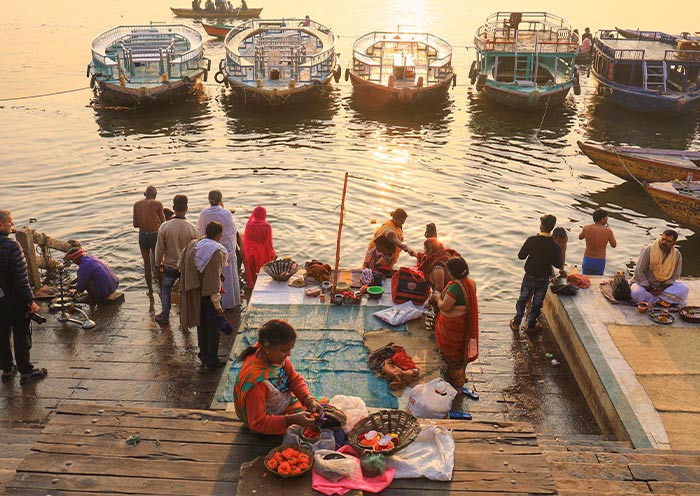
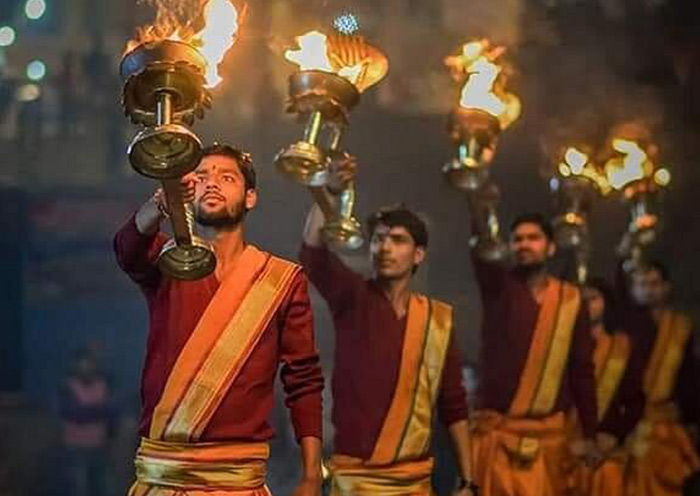
Attraction of India's Rajput Era: Attraction Showcasing Legacy of Honor & Valor
The Rajput Era in India has left behind a vibrant legacy. The top cultural attractions of this era, such as the majestic forts of Mehrangarh and Amber, stand as testaments to the military prowess and architectural brilliance of the Rajput rulers. Elaborate palaces found in Udaipur and Jodhpur offer a glimpse into their opulent royal lifestyle. There are also Temples and stepwells scattered throughout the region.
13 Amber Fort: Rajput's Glorious Heritage Through Time
Amer Fort (16th century): Rajput clan (Kachwaha dynasty), Hindu cultural heritage.
Standing tall on a hilltop overlooking Jaipur, Amber Palace, also known as Amer Fort, is a majestic example of Rajput architecture and heritage with influences of Mughal and European architectural styles. Built in the 16th century, it served as the royal residence of the Rajput rulers of Jaipur until the 17th century. The intricate carvings, vibrant murals, and sprawling courtyards showcase the artistic mastery and cultural grandeur of the Rajput era.
Tourists to Amber Palace can embark on a captivating journey through history. Explore the Diwan-e- عام (Hall of Public Audience) and Diwan-e- Khas (Hall of Private Audience), marvel at the Sheesh Mahal (Mirror Palace) adorned with thousands of tiny mirrors, and climb to the top for breathtaking views of the surrounding Aravalli Hills.
Amber Palace Attraction Information:- Location: Amer, Jaipur, India
- Opening Hours: 9:00 AM to 5:30 PM (closed on Mondays)
- Ticket Price: ₹500 (approx. US$6.20) for foreign tourists
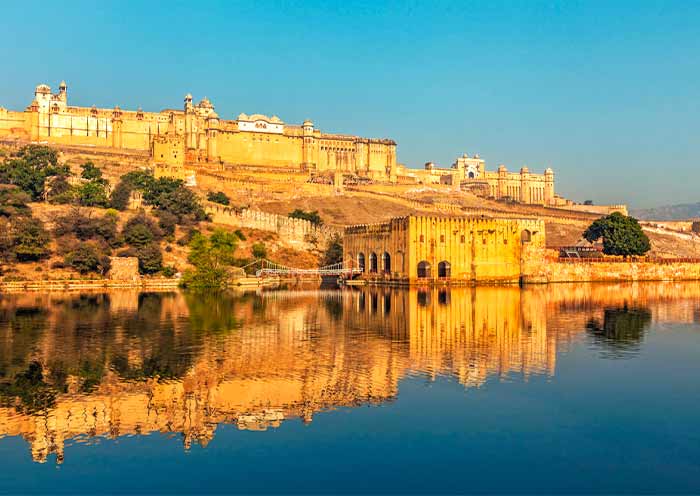
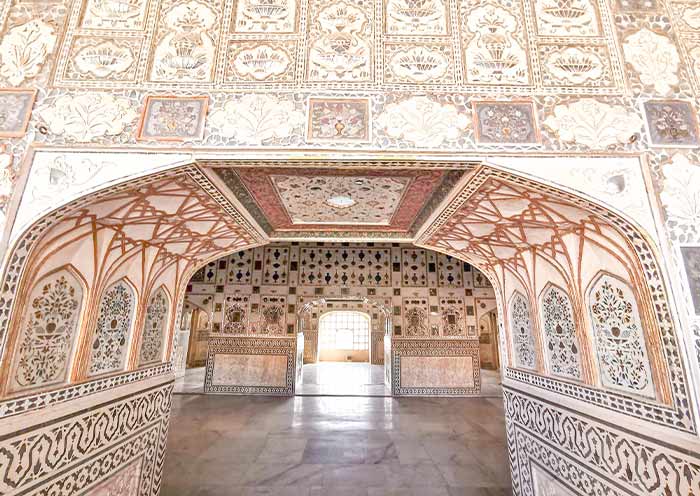
14 The City Palace: Udaipur's Cultural Heritage of the Mewar Dynasty
City Palace of Udaipur (16th - 19th centuries): Mewar dynasty, Rajput cultural heritage.
The City Palace of Udaipur, a top Indian attraction and a famous cultural heritage site in India, provides a captivating glimpse into the grandeur and cultural legacy of the Mewar dynasty. Standing proudly on the banks of Lake Pichola, this magnificent palace complex has a history spanning nearly 400 years, starting in the 16th century. It served as the royal residence for the Sisodia Rajputs, bearing witness to a rich and eventful past. The City Palace encompasses a plethora of palaces, courtyards, and museums that offer a fascinating insight into the lives, traditions, and artistic expressions of the Mewar rulers.
Embark on a captivating journey through Mewar's legacy as you explore the intricate courtyards adorned with vibrant murals and delicate mosaics. Marvel at the architectural brilliance displayed in the various palaces, each showcasing a unique fusion of Rajput and Mughal styles. Immerse yourself in the courtly life of Mewar through exhibits featuring royal artifacts, weaponry, costumes, and paintings. The City Palace presents tourists with an enchanting opportunity to travel through time, appreciating the artistic legacy and captivating history of the Mewar dynasty, further enhancing India's rich cultural heritage and tourism offerings.
City Palace of Udaipur Attraction Information:- Location: Located on the eastern banks of Lake Pichola, Udaipur, India
- Opening Hours: 9:00 AM to 5:00 PM (all days)
- Entry Fee: ₹300 (approx. US$3.70) for adults
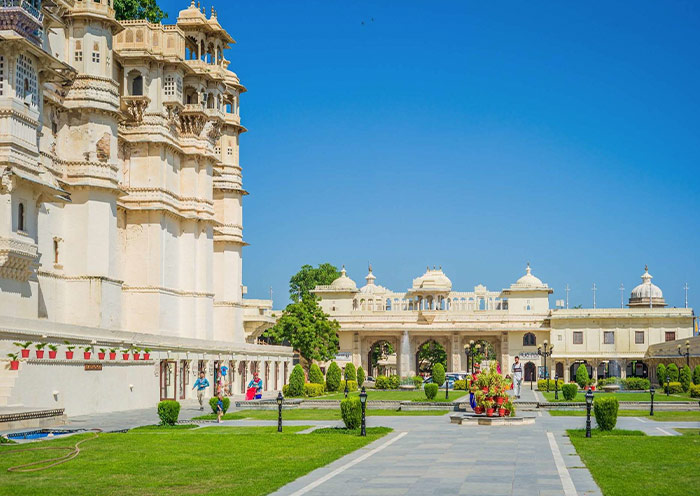
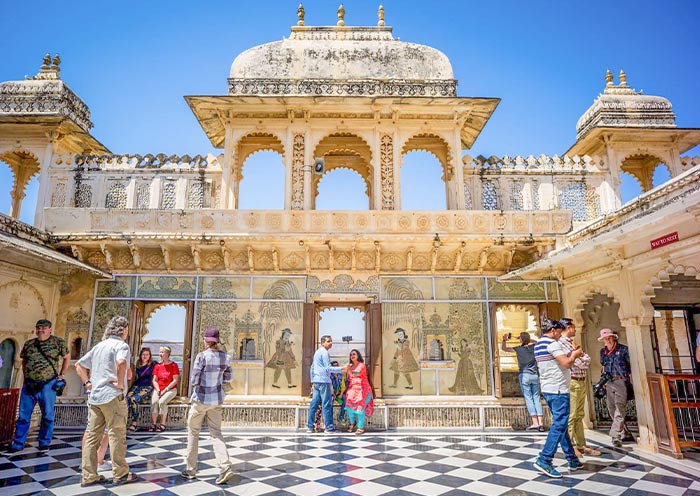
15 Mehrangarh Fort: Fort of the Sun Rising from Desert Sands
Mehrangarh Fort (15th century onwards): Rajput clan (Rathore dynasty), Hindu cultural heritage.
Mehrangarh Fort, a top Indian attraction and a famous cultural heritage site in India, known as the "Fort of the Sun," commands a majestic presence atop a hill in Jodhpur. Constructed in the 15th century, this fort served as the formidable stronghold of the Rathore clan, epitomizing the resilience and architectural brilliance of the Rajput dynasty. The City Palace of Udaipur also houses the Crystal Gallery, which displays a rare collection of crystal objects, furniture, and chandeliers.
Tourists to Mehrangarh Fort can embark on a captivating exploration of its sprawling complex, marveling at its intricate carvings, expansivecourtyards, and immersive museums. From the ramparts, take in panoramic views of the enchanting Blue City, offering a picturesque vista of Jodhpur's unique charm. Witnessing a cannon demonstration provides a fascinating and exclusive glimpse into the fort's historic legacy, further enhancing the allure of Mehrangarh Fort as a must-visit destination for cultural heritage enthusiasts and tourists in India.
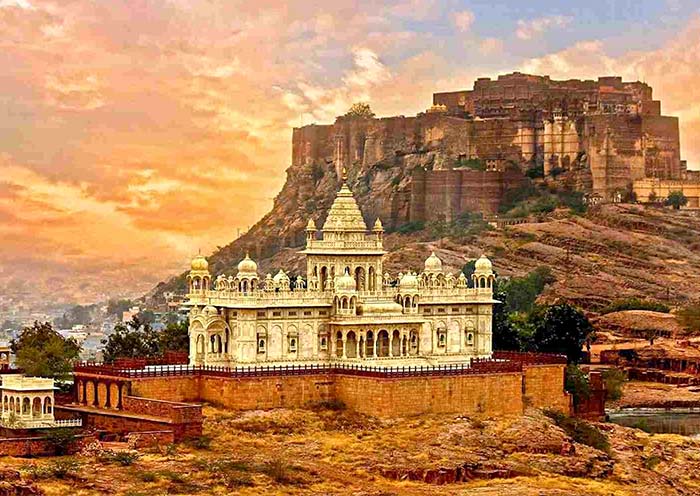
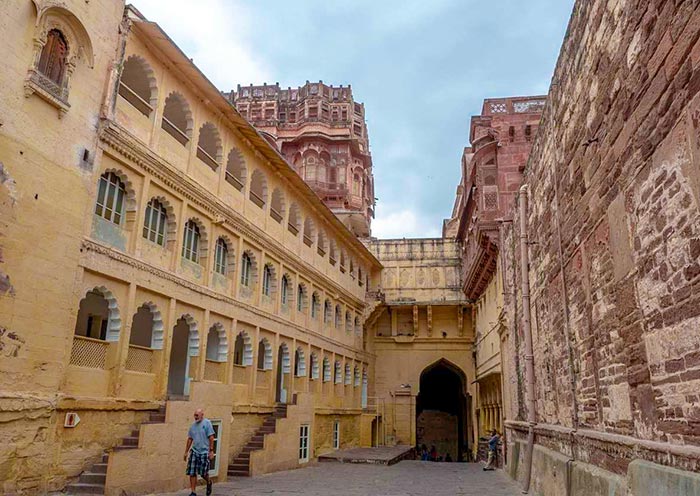
16 Hawa Mahal: Palace of Winds, One of The Most Beautiful Attractions of India
Hawa Mahal (1799 CE): Rajput clan (Kachwaha dynasty), Late Mughal and Rajput influences.
Hawa Mahal, a top Indian attraction and a famous cultural heritage site in Jaipur, is also known as the "Palace of Winds." It stands as a remarkable testament to the ingenuity and cultural richness of India. Constructed in the 18th century by Maharaja Sawai Pratap Singh, this architectural marvel served as an extension of the City Palace, providing royal women with a vantage point to observe street life while maintaining their privacy. The stunning latticework facade, boasting 953 windows, is a true embodiment of the distinctive Rajput architectural style, perfectly reflecting Jaipur's renowned nickname, the "Pink City."
A visit to Hawa Mahal offers a captivating glimpse into the lives of the Rajput royalty. Ascend the narrow steps and peer through the intricately designed jharokhas (windows) to envision the vibrant and bustling life below, just as the women of the royal court once did. The delicate pink sandstone facade, along with the natural cooling effect created by the multitude of windows, provides a unique and enthralling experience, allowing tourists to immerse themselves in the architectural splendor and rich history of India.
Hawa Mahal Attraction Information:- Location: Hawa Mahal Road, Jaipur, India
- Opening Hours: 9:00 AM to 5:30 PM (all days)
- Entry Fee: ₹50 (approx. US$0.60)
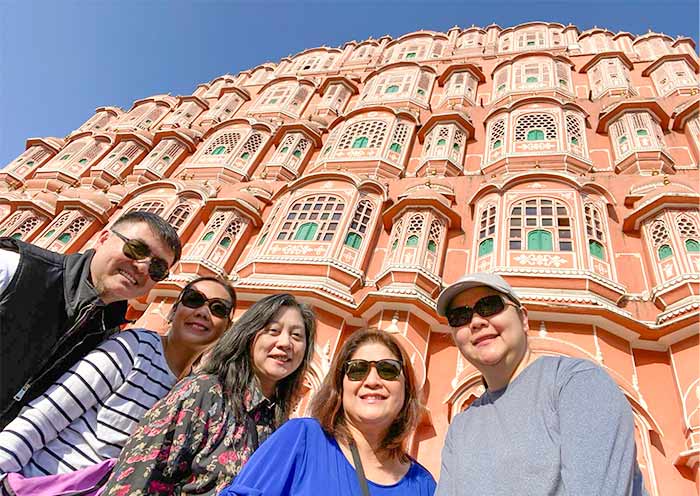
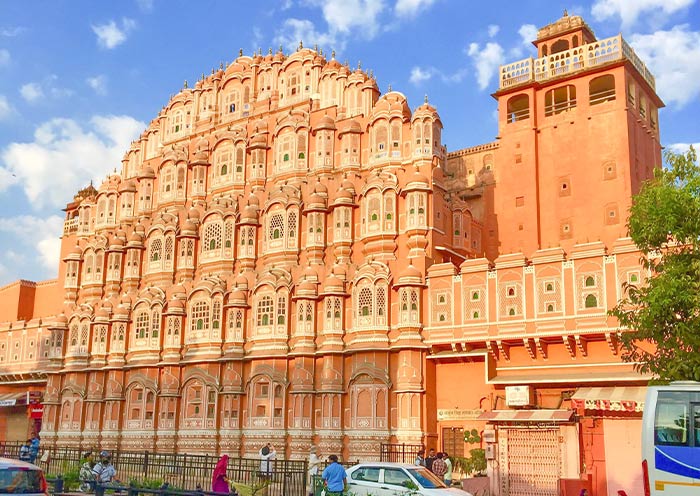
Attractions of Colonial Era: A Complex Legacy in Stone and Steel
For attractions from India's Colonial, tourists can explore top cultural attractions that showcase architectural marvels famous for reflecting European styles. The Victoria Memorial and the Gateway of India, in particular, stand as iconic examples of these attractions. Additionally, hill stations like Darjeeling provide a unique opportunity to witness the leisurely lifestyle of the British Raj. Alongside, railway stations and administrative buildings offer a glimpse into the colonial planning that shaped the infrastructure of the time.
17 The Gateway of India: Indo-Saracenic Architectural Heritage, A Must-see Attraction
The Gateway of India (1911 CE): British Raj (Indo-Saracenic Revival architecture).
The Gateway of India, an iconic Indian attraction in Mumbai, serves as a significant symbol of the country's colonial heritage and its journey towards nationhood. Built in the early 20th century, it's an Indo-Saracenic blend, combining European triumphal arch form with touches of Mughal details and jali screens.
tourists can admire the Gateway's grandeur - the 26-meter arch, intricate carvings, and stunning harbor views. It's a bustling spot for people-watching, capturing the city's vibrant life and colonial past.
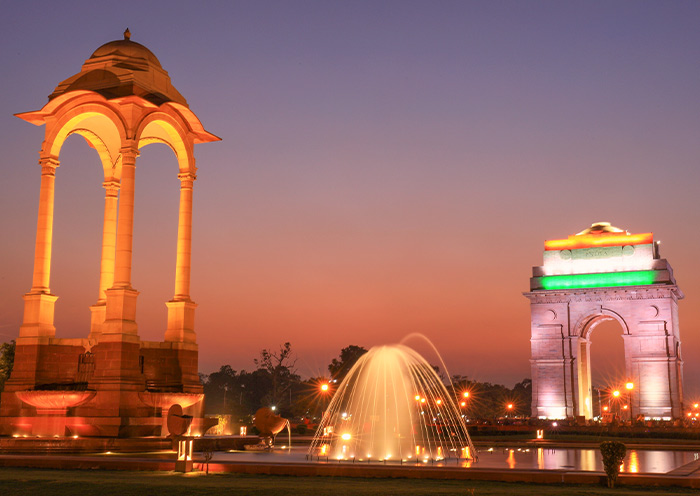
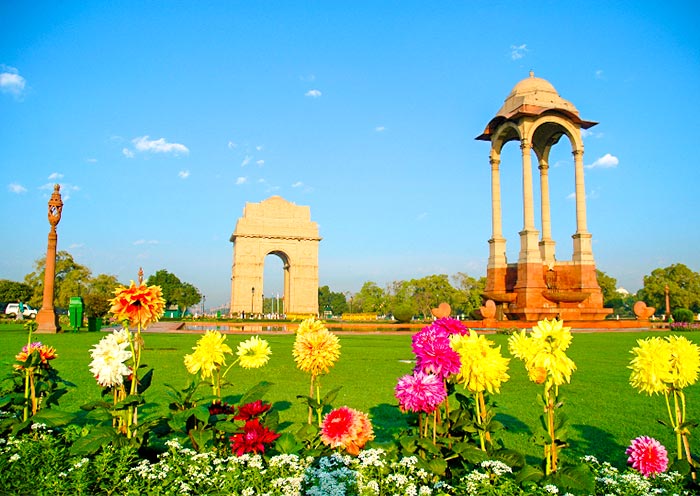
18 Chhatrapati Shivaji Terminus (Victoria Terminus): Attraction as Living Testament
Chhatrapati Shivaji Terminus (1887 CE): British Raj (Victorian Gothic Revival architecture).
Chhatrapati Shivaji Terminus (CST), formerly known as Victoria Terminus, stands as a famous Indian attraction, a UNESCO World Heritage Site, and an iconic symbol of Mumbai, India. Constructed in the late 19th century, it seamlessly blends Victorian Gothic Revival architecture with Indian influences, representing the city's colonial past and cultural heritage. Beyond being a bustling station, the terminus serves as a living testament to Mumbai's historical journey and its rich architectural legacy.
tourists are greeted by the mesmerizing facade adorned with intricate statues and carvings, the majestic high vaulted roof, and the grand central hall. The terminal's grandeur instills a profound sense of wonder, transporting tourists to a bygone era of travel and showcasing the architectural splendor of that time.
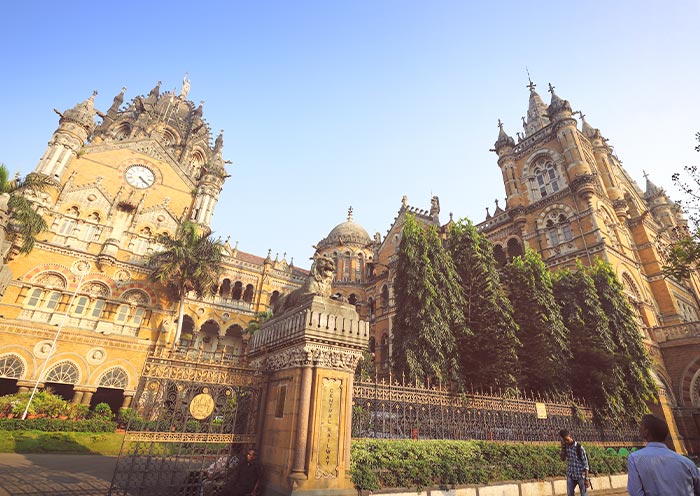
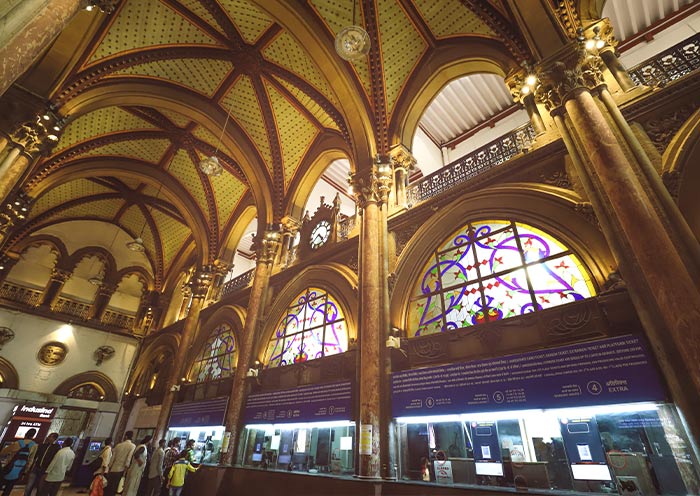
19 The Jantar Mantar: Old Science Deciphering the Heavens, One Sundial at a Time
The Jantar Mantar (1720s CE): Mughal Empire (Sawai Jai Singh II), Scientific and astronomical purposes.
The Jantar Mantar, situated in Jaipur, India, is a top cultural attraction and a significant heritage site that goes far beyond being a collection of astronomical instruments. It stands as a captivating testament to scientific curiosity and cultural exchange of Rajasthan. Constructed in the early 18th century by Maharaja Sawai Jai Singh II, a renowned astronomer-king, the Jantar Mantar represents the zenith of pre-modern astronomical observation through the use of monumental instruments. These structures embody the harmonious blend of Mughal and European scientific knowledge, showcasing the intellectual exchange that characterized the era.
Stepping into the Jantar Mantar is akin to stepping into a bygone era of scientific exploration. Tourists are awe-struck by the towering Samrat Yantra, a colossal sundial, and are intrigued by the intricate workings of the Jai Prakash Yantra, a cylindrical structure used to predict the positions of celestial bodies. The grand scale and ingenious design of these instruments evoke a profound sense of wonder and inspire contemplation about humanity's relentless pursuit of understanding the universe.
Jantar Mantar Attraction Information:- Location: Jaipur, Rajasthan, India
- Opening Hours: Daily (sunrise to sunset)
- Ticket Prices: Foreign Tourists: ₹200 (approx. USD 2.45)
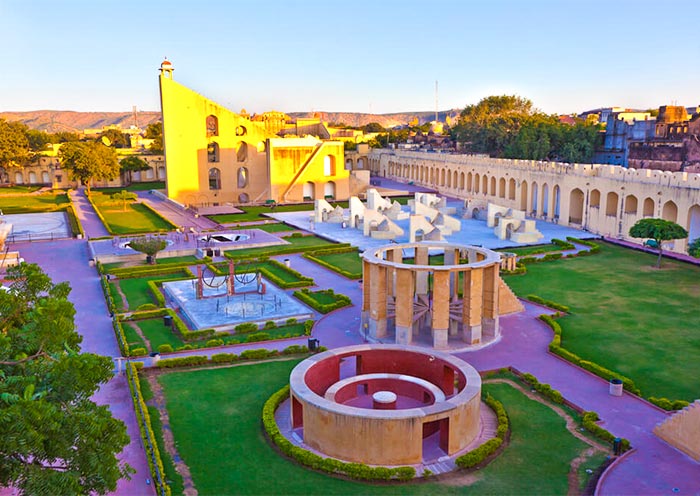
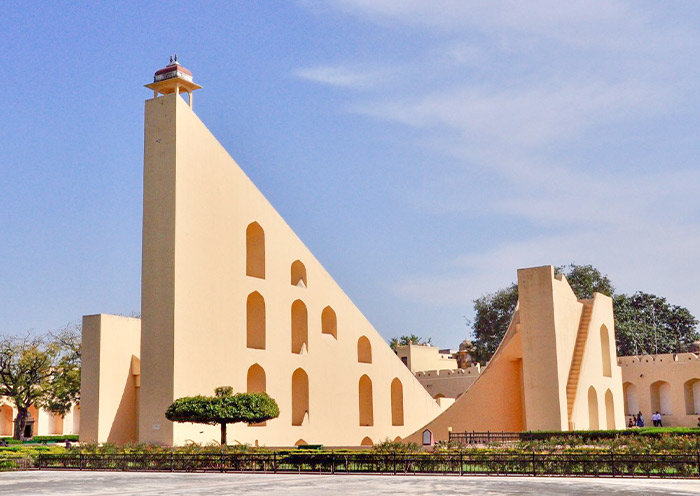
20 Basilica of Bom Jesus: The Soul of Goa's Catholic Heritage
Basilica of Bom Jesus (1594-1605 CE): Christianity (Portuguese colonial period).
A UNESCO World Heritage Site, the Basilica of Bom Jesus is Goa's most revered church. Enshrining the remains of St. Francis Xavier, it's a pilgrimage site for Christians and a symbol of Goa's Portuguese colonial heritage.
Marvel at the Baroque architecture, with its ornate facade, gilded altars, and exquisite tomb of St. Francis Xavier. Explore the chapels and sacristy, experiencing the rich history and artistic legacy of Goa.
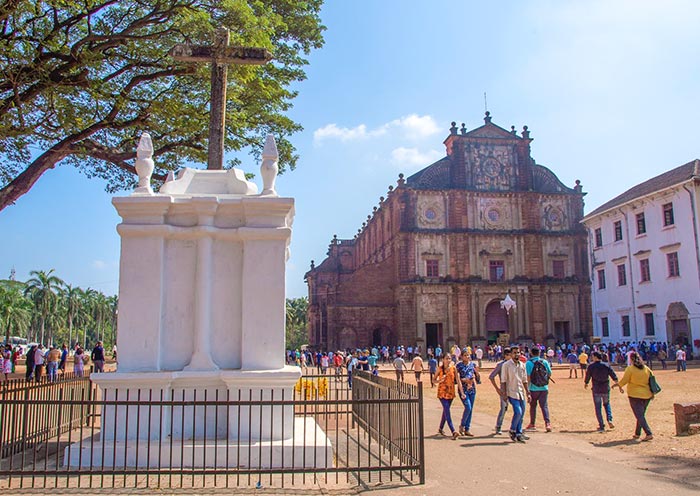
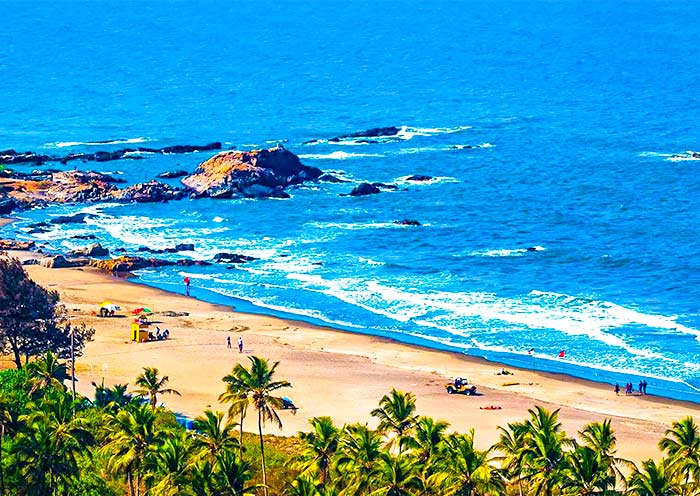
Tips for Visiting Cultural Heritage Attractions in India
- Respectful Attire: Shoulders & knees covered at religious sites. Remove shoes in temples & mosques.
- Etiquette: Ask before photographing people. Respectful volume in prayer areas. Carry small change for vendors.
- Respectful Behavior: Don't disrupt religious practices. Support charities, not beggars. Dispose of waste responsibly.
- Be prepared for crowds: Waiting time could go up to half or a full hour before entry. A tour group might get you exclusive faster entry access at certain cultural heritage attractions in India.
- Enhance Your Experience: Hire a licensed guide. Learn basic Hindi phrases. Bargain respectfully, tip appropriately.
India Travel Need to Know:
- Packing List - Accommodation - Reasons to Visit - 1 Week Itinerary - Travel FAQs
- Travel Cost - Travel Safety - How to Plan India Trip - First Timer Itinerary - India Travel Info
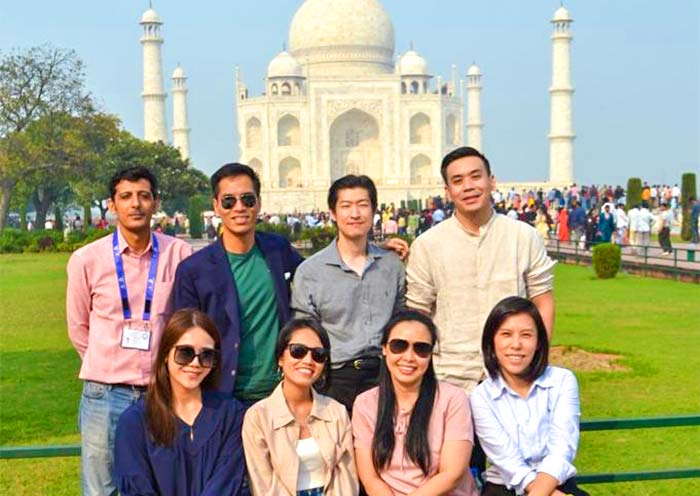
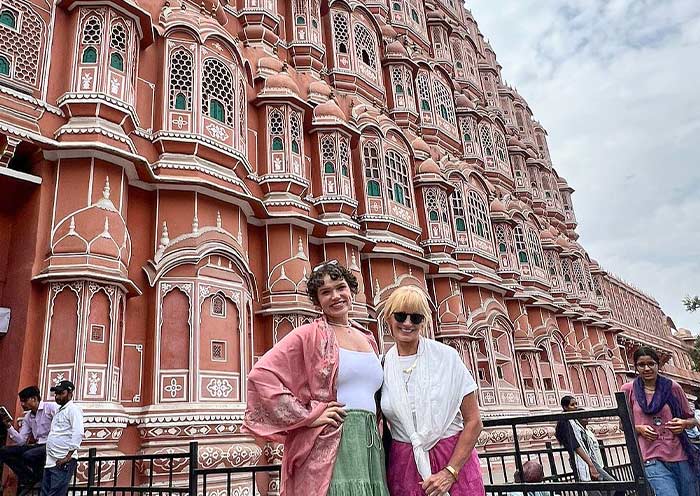
Travel with AOT to Discover the Enchanting Heritage of India
We all dream of embracing India's enchanting chaos - bustling streets, biodiversity, vibrant culture, and ancient heritage - but it can be overwhelming, especially for couples and families when navigating through the confusing yet vast public transportation with potential safety concerns, and figuring out itineraries with countless attractions on the list.
That's where we come in! Asia Odyssey Travel with over a decade of expertise and deep-rooted local connections, crafts journeys that unveil the true essence of the Himalayan Regions, including India. We started our business in Tibet 14 years ago and have built local teams and networks in Bhutan, Nepal, and all across Asia. And of course, how could we miss India? One of the most fascinating destinations in the world!
Choose Asia Odyssey Travel! Get lost in India's Charms, Not Lost in India!
- Personalized Planning: Skip the research, craft your India Itinerary with our travel expert
- Peace of Mind: Flights, buses, trains, hotels? We handle it all!
- Hiccups? We're your 24/7 travel guardian.
- Safe travel: Your safety, Our Priority!
- Time-saving: One-stop shop, say goodbye to endless booking hassles
- Journey with Awareness: AOT's local team ensures experiences that are culturally sensitive
- Travel like a Local: Insider tips, secret savings, and authentic experiences await with our local guides
Asia Odyssey Travel, Your Best Travel Mate. Turn Travel Dreams into Reality!
Contact Us today, embrace the Incredible India!
